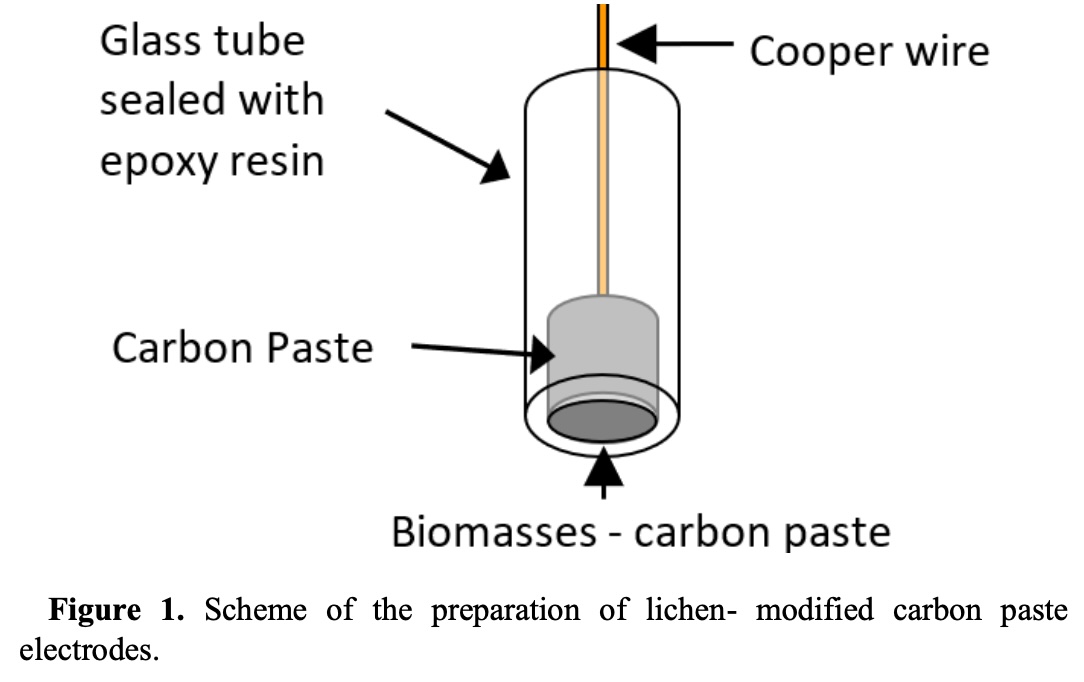CHILEAN LICHEN AND MOSSES MODIFIED CARBON PASTE ELECTRODES FOR MONITORING DISSOLVED ECOTOXIC METAL IONS
- Lichens,
- mosses,
- modified electrodes,
- Ecotoxic metals
Copyright (c) 2024 SChQ

This work is licensed under a Creative Commons Attribution-NonCommercial-ShareAlike 4.0 International License.
Abstract
Lichens (a symbiotic association of fungi and algae) and mosses are capable of accumulating heavy metals in their tissues. The retention of ecotoxic metals may take place in the functional groups that contain oxygen and nitrogen atoms, most likely carboxylic groups that form part of the cell wall of the fungus, through an ion exchange process. In this work, the study of carbon-lichen paste electrodes and carbon-moss paste electrodes has been carried out. Eighteen species of lichens and two species of mosses were used as sensitive agents. Additionally, the response of each of them with nine metal ions such as Cu, As, Pb, Hg, Zn, Cd, Al, Mo and Cr was studied. Being the electrode that is most sensitive to the lichen Protousnea Magallánica and the mosses Hypnum Cupresiforme and Ortotrichum Assimile, it presents better signals with the lead (II), Copper (II) and Mercury (II) ion.

References
- - Z. Jyh-Myng, K. Annamalai, T. Dong-Mung, Electroanalysis, 15(13), 1073-1087 (2003)
- - E. Grant, A. Bergen, M. Porter, Handbook of electrochemistry, 295-327 (2007)
- - R.P. Baldwin, J.K. Christensen, L. Kryger, Anal. Chem., 58, 1790-1798 (1986)
- - A.R. Guadalupe, H.D. Abruna, Anal. Chem., 57, 142-149 (1985)
- - S.V. Prabhu, R.P. Baldwin, L. Kryger, Anal. Chem., 59, 1074-1078 (1987)
- - J. Wang, B. Greene, C. Morgan, Anal. Chim. Acta. 158, 15-22 (1984)
- - M.N. Szentirmay, C.R. Martín, Anal. Chem., 56, 1898-1902 (1984)
- - J.A. Cox, P. Kulesza, J. Anal. Chim. Acta, 154, 71-78 (1983)
- - J.F. Price, R.P. Baldwin, Anal. Chem., 52, 1940-1944 (1980)
- - H. Arslan, D. Senarslan, B.S. Cevrimli, H. Zench, D. Uzunn, F. Arslan, Bulgarian chemical communications, 50(1), 16-20 (2018)
- - J.G. Manjunatha, Chem. Data Collect, 25, 100331 (2020)
- - N.P. Shetti, D.S. Nayak, S.J. Malode, R.M. Kulkarni, Sens. Bio-Sens. Res., 14, 39-46 (2017)
- - K.K. Somashekharappa, R. Shashanka, Emerging Research Trends in Devices and Applications, 3-12 (2020)
- - O.B. Ojuederie, O.O. Babalola, Microbial and Plant-Assisted Bioremediation of Heavy Metal Polluted Environments: A Review. Int J Environ Res Public Health, 14(12), 1504 (2017)
- - M. Kapahi, S. Sachdeva, J Health Pollut. 9(24), 1-20, (2019)
- - M.U. Mustapha, N. Halimoon, J. of microbial and biochemical technology, 7(5), 253-256 (2015)
- - H. Yao, G.J. Ramelow, Talanta, 45, 1139-1146 (1998)
- - M.E. Conti, G. Cecchetti, Environmental pollution, 114(3), 471-492 (2001)
- - J.J. Armesto, C. Villagran, M.K. Arroyo, Ecología de los bosques nativos de Chile, Cap.5, David Galloway., Ed. Universitaria S.A., 1996, pp. 101-112.
- - M. Rossbach, S. Lambrecht, Croatica Chemica Acta. 79(1), 119-124 (2006)
- - E. Dempsey, M.R. Smyth, D.H.S. Richardson, Analyst, 117, 1467-1470 (1992)
- - K.J. Puckett, E. Nieboer, M.J. Gorzynski, D.H.S. Richardson, New Phytologist, 72(2), 329-342 (1973)
- - M. Backor, S. Loppi, Biologia. Plant, 53(2), 214-222 (2009)
- - P.R. Bell, J. of Ecology, 47(2), 351-355 (1959)
- - A.M. Spearing, The Bryologist, 75(2), 154–158 (1972)
- - M. Schmeling, F. Alt, R. Klockenkämper, D. Klockow, Fresenius' j. analytical chem., 357, 1042-1044 (1997)
- - A.V. Filgueiras, I. Lavilla, C. Bendicho, Fresenius' j. analytical chem., 369, 451-456 (2001)
- - M. Connor, E. Dempsey, M.R. Smyth, D.H.R. Richardson, Electroanalysis, 3(4‐5), 331-336 (1991)
- - J. Wang, B. Tian, G. Royson, Talanta, 39(12), 1637-1642 (1992)
- - J.A. Ramos, E. Bermejo, A. Zapardiel, J.A. Perez, L. Hernandez, Analytica chimica acta, 273(1-2), 219-227 (1993)
- - J. Garty, M. Kauppi, Environ. Toxic. Chem., 16, 2404-2408 (1997)
- - M. Darder, M. Colilla, N. Lara, E. Ruiz-Hitzky, J. Mater. Chem., 12, 3660-3664 (2002)
- - K. Kalcher, J.M. Kauffmann, J. Wang, I. Svancara, K. Vytras, C. Neuhold, Z. Yan, Electroanalysis 7, 5-22 (1995)

